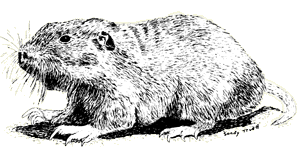What Burrowing Desert Animal Will Refill The Opening If His Tunnel With Dirt

Pocket Gophers
The fossorial (burrowing) pocket gopher is a rarely seen animal, since it spends almost its unabridged life hole-and-corner in its all-encompassing tunnels. Only the many mounds of dirt on the surface show where these animals are active. The mounds accept no visible holes, because the gophers plug them from underneath. Occasionally the gopher opens a pigsty to permit some air exchange in the tunnel, or to let the tunnels dry out subsequently heavy rains.
These little animals are active year circular, always digging and extending their tunnel systems. They perform a valuable service in turning and aerating the soil. Many other creatures such as rabbits, ground squirrels, mice, skunks, snakes, lizards, and toads use gopher holes and tunnels.
�Pinau Merlin
Sonoran Desert species:
Botta�s pocket gopher (Thomomys bottae)
Order: Rodentia
Family unit: Geomyidae
Spanish Names: tuza, topo
Distinguishing Features
This heavy-bodied animal is about 9H inches (24 cm) long and weighs half dozen to 8 ounces (170-225 grand). It has very minor ears and eyes, a short naked tail and large forelimbs with long claws. The lips close behind the large incisor teeth, so that the teeth are always visible. This gopher ranges in colour from stake greyness or white to almost black.
Habitat
Pocket gophers are found throughout the Sonoran Desert region where there are hands dug soils, such equally those in riparian areas, washes, farms, mesquite bosques and golf courses. They are institute at all elevations, just non ordinarily in the hard caliche soils of the desert.
Feeding
� Diet: These animals are vegetarians, eating roots, tubers, grasses, green plants, and prickly pears.
� Behavior: Pocket gophers are very shy and timid, seldom leaving their underground tunnel systems. They prefer to pull plants down into the tunnel from below. They also store nutrient for lean times in chambers off the main tunnel.
Life History
 |
Although male gophers leave their tunnels to seek mates, and 2-month-old youngsters leave home to establish their own territories, pocket gophers spend almost of their time underground in their own tunnels. A pocket gopher but occasionally ventures to the surface for a tasty constitute, or to dump a load of clay. Information technology rarely moves far from the tunnel entrance, and if startled, speedily retreats backward down the hole. A sensitive tail helps the fauna feel its way every bit it runs backward through its ninety to 200 foot (27-61 grand) long tunnel. Side chambers are used for food storage, latrines or nest chambers.
The gopher�s teeth are continuously growing (ix to 14 inches/23 to 35 cm a year!) and must exist kept trimmed past constant gnawing. Both the teeth and the long claws are used for earthworks, and the gopher�southward lips shut behind its teeth so that dirt doesn�t get in its mouth while it digs. Gophers are solitary, but getting together for mating one time or perchance twice a year, with 2 to 6 young built-in xix days later. These youngsters will be sexually mature adults in 3 months.
Source: https://www.desertmuseum.org/books/nhsd_gophers.php
Posted by: ballauneance.blogspot.com

0 Response to "What Burrowing Desert Animal Will Refill The Opening If His Tunnel With Dirt"
Post a Comment